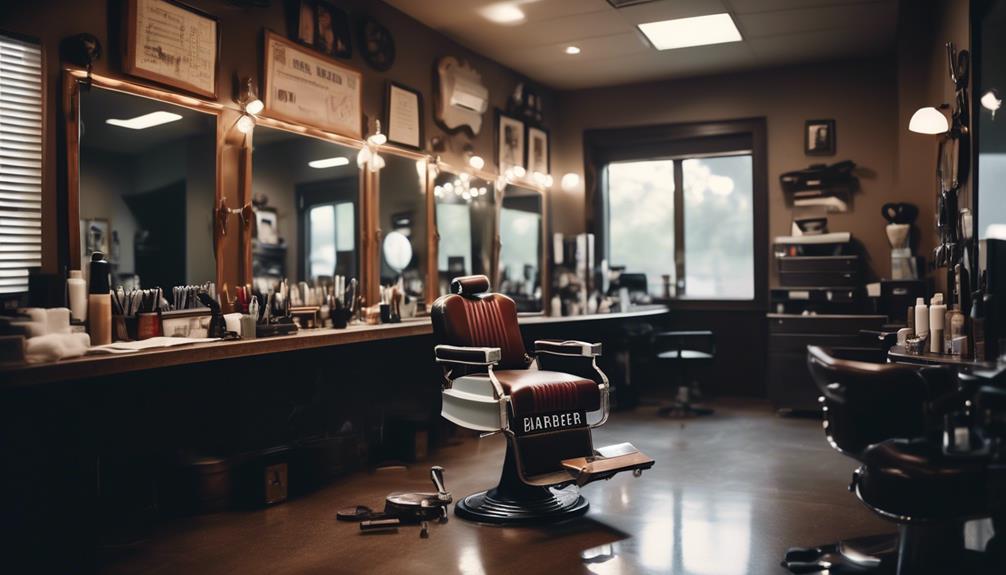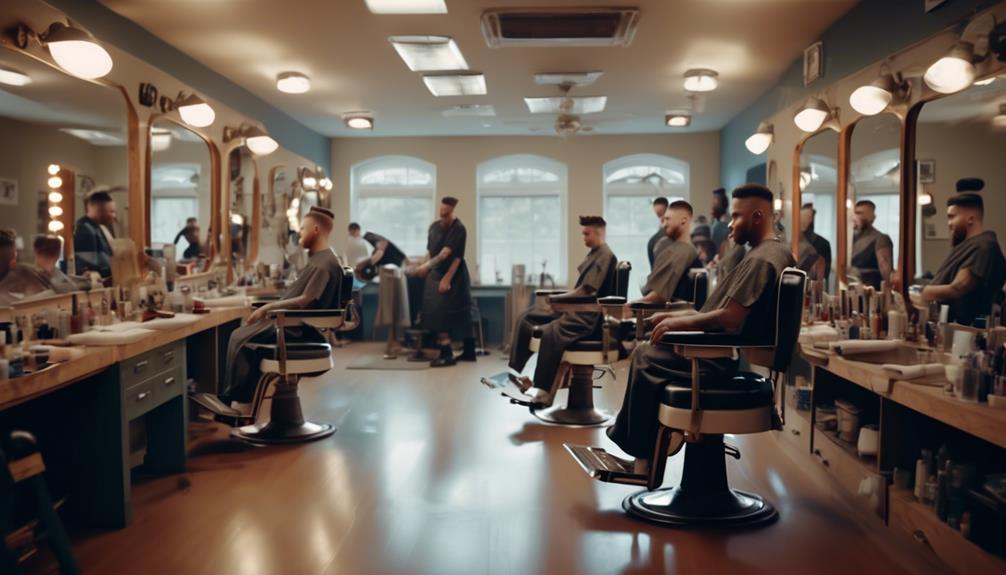Barbering is a timeless profession that continues to thrive in today's world, offering individuals the opportunity to showcase their skill and creativity. However, before embarking on this fulfilling career, one must first consider the cost of attending barber school. It is essential to weigh the financial investment against the potential return and opportunities that await. From tuition fees and supplies to additional expenses and possible financial aid options, understanding the full extent of the costs involved is crucial. In this discussion, we will delve into each aspect, providing valuable insights and shedding light on the factors that influence the cost of barber school.
Key Takeaways
- The cost of barber school can range from $5,000 to $20,000, including tuition fees, program materials, licensing exam fees, equipment costs, and supply costs.
- Financing plans, scholarships, and federal financial aid programs may be available to help cover tuition costs.
- Barber schools have job placement services and networking opportunities for graduates, with a favorable job outlook in the grooming industry.
- Barber schools provide comprehensive training programs that cover haircutting techniques, styling, grooming, sanitation, and safety procedures, with some offering specialized courses in men's grooming trends.
Tuition Fees

The tuition fees for barber school can vary depending on factors such as location, program length, and additional costs. It is important for prospective students to understand the cost breakdown and explore various payment options to make an informed decision.
The cost breakdown for barber school typically includes tuition fees, program materials, and licensing exam fees. Tuition fees can range from $5,000 to $20,000, depending on the school and location. Program materials, such as textbooks and barbering tools, can add an additional $1,000 to $2,000 to the overall cost. Licensing exam fees, which are required to become a licensed barber, can range from $100 to $300.
When it comes to payment options, many barber schools offer financing plans or scholarships to help students cover the cost of tuition. Financing plans allow students to pay off their tuition in installments, making it more manageable. Scholarships, on the other hand, provide financial assistance to students who demonstrate exceptional skills or financial need.
In addition to financing plans and scholarships, some students may also qualify for federal financial aid programs, such as grants or loans. These options can further alleviate the financial burden of barber school tuition.
It is advisable for prospective students to research and compare different barber schools to find the best combination of affordability and quality education. By understanding the cost breakdown and exploring payment options, individuals can make a well-informed decision that aligns with their financial situation and career goals.
Supplies and Equipment
To fully understand the costs associated with attending barber school, it is essential to examine the expenses related to supplies and equipment. Barber school equipment and supplies play a crucial role in the education and training of aspiring barbers. These items are necessary for students to develop their skills and gain hands-on experience in the industry.
Barber school equipment encompasses a wide range of tools and instruments used in the practice of barbering. This includes barber chairs, clippers, trimmers, razors, shears, combs, brushes, styling products, and disinfectants. The cost of these items can vary depending on the brand, quality, and specific requirements of the school. On average, students can expect to spend anywhere from $500 to $1,000 on barber school equipment.
In addition to equipment, barber school supplies are also essential for students' education. These supplies include textbooks, workbooks, mannequin heads, practice materials, and uniform attire. The cost of these supplies can range from $200 to $500, depending on the program's curriculum and requirements.
It is important for aspiring barbers to carefully consider the cost of supplies and equipment when budgeting for barber school. These expenses are in addition to tuition fees and can significantly impact the overall cost of education. Some schools may provide a list of required supplies and equipment, while others may offer package deals or allow students to purchase items individually.
Additional Expenses

Expenses beyond tuition and supplies can significantly impact the overall cost of attending barber school. It is essential for prospective students to consider these additional expenses when planning for their education. In addition to the cost of tuition and supplies, there are licensing requirements and apprenticeship opportunities that aspiring barbers should take into account.
- Licensing requirements:
- Obtaining a barber license is a crucial step towards a successful career in the industry. However, the process of obtaining a license often comes with additional costs. These costs can include application fees, examination fees, and licensing fees. The exact fees vary by state, so it is important for students to research and understand the requirements of the state in which they plan to practice.
- Apprenticeship opportunities:
- Many barber schools offer apprenticeship programs as part of their curriculum. While these programs provide valuable hands-on experience and mentorship, they may come with additional costs. Some schools charge an additional fee for apprenticeship programs, while others may require students to work a certain number of hours without pay.
Prospective barber school students should carefully consider these additional expenses when planning their education. It is important to research the licensing requirements of the state in which they plan to practice and factor in the associated costs. Additionally, students should inquire about any fees or requirements related to apprenticeship opportunities offered by their chosen school. By accounting for these additional expenses, students can make informed decisions and ensure that they are fully prepared for the financial commitment of attending barber school.
Financial Aid and Scholarships
Considering the financial implications of attending barber school, exploring financial aid and scholarship opportunities becomes crucial for prospective students. Barber school can be a significant investment, and many students may require financial assistance to pursue their education. Fortunately, there are various financial aid options available to help alleviate the burden of tuition fees and other educational expenses.
One of the primary financial aid options for barber school students is federal financial aid. The Free Application for Federal Student Aid (FAFSA) is a common starting point for students seeking financial aid. By completing the FAFSA, students can determine their eligibility for federal grants, work-study programs, and student loans. Additionally, some states offer their own financial aid programs specifically for vocational schools, which may be worth exploring.
Apart from federal aid, students can also explore scholarships. Scholarships are typically awarded based on specific criteria such as academic achievements, financial need, or community involvement. Many organizations, foundations, and even barber schools themselves offer scholarships to deserving students. It is important to research and identify scholarships that align with one's eligibility criteria and goals.
Some barber schools may also offer in-house financial aid options, such as payment plans or tuition assistance programs. These options can help students break down the cost of tuition into manageable monthly payments or reduce the overall financial burden through grants or scholarships provided directly by the school.
Return on Investment

The return on investment for attending barber school can be evaluated through various objective and data-driven measures. Aspiring barbers invest their time, effort, and money into their education with the expectation of securing promising career opportunities and job placement. Here are some key points to consider when assessing the return on investment for barber school:
- Career Opportunities:
- Graduates of barber school can find employment in a variety of settings, including barbershops, salons, spas, and even self-employment as independent barbers.
- The demand for barbers remains steady, as people will always need haircuts and grooming services, ensuring a consistent stream of job opportunities in this field.
- Job Placement:
- Many reputable barber schools have established relationships with local businesses and industry professionals, providing students with valuable networking opportunities and potential job placements upon graduation.
- Some barber schools even offer job placement assistance services, helping their graduates find suitable employment in their desired locations.
Considering the increasing demand for skilled barbers and the growth of the grooming industry, the return on investment for attending barber school can be quite promising. According to the U.S. Bureau of Labor Statistics, the employment of barbers is projected to grow 8 percent from 2018 to 2028, which is faster than the average for all occupations. This indicates a favorable job outlook and increased chances of finding employment in the field after completing barber school.
Frequently Asked Questions
Are There Any Prerequisite Qualifications or Education Required to Enroll in Barber School?
Before enrolling in barber school, it is important to consider any prerequisite qualifications or education requirements. While each school may have its own specific criteria, generally, a high school diploma or GED is required. Some programs may also require applicants to have completed certain courses or have prior experience in the field. Additionally, financial aid options such as scholarships, grants, and loans may be available to help with the cost of tuition and other expenses.
How Long Does It Typically Take to Complete Barber School and Obtain a License?
On average, it takes around 9 months to 2 years to complete barber school and obtain a license. This time frame can vary depending on the program and the individual's dedication. The completion time includes both classroom instruction and hands-on training. As for the cost breakdown, barber school tuition can range from $5,000 to $20,000, depending on the location and the type of program. Additional expenses may include textbooks, supplies, and licensing fees.
What Are the Job Prospects Like After Graduating From Barber School?
After graduating from barber school, the job prospects in the barbering industry are quite promising. The barber school job market offers a wide range of employment opportunities, including working in barbershops, salons, or even starting one's own business. With the increasing popularity of male grooming and the demand for skilled barbers, there is a steady demand for qualified professionals in this field. This presents a favorable outlook for individuals seeking a career in barbering after completing their training.
Can I Work While Attending Barber School to Help Cover My Expenses?
Working part-time while attending barber school can be a viable option for those looking to cover their expenses. Many barber schools offer flexible schedules, allowing students to allocate time for both work and classes. Additionally, financial assistance options such as scholarships, grants, and loans may be available to help alleviate the financial burden. It is important for prospective students to research and inquire about these opportunities to determine the best course of action for their individual circumstances.
Are There Any Specific Certifications or Licenses I Will Need to Obtain After Completing Barber School?
After completing barber school, there are several additional certifications and licenses that you may need to obtain in order to practice legally. These certifications and licenses vary by state, but common ones include the Barber License, which requires passing a written and practical exam, and the Health and Safety Certification, which ensures that barbers are knowledgeable about sanitation and safety procedures. The process of obtaining these certifications and licenses typically involves submitting an application, paying a fee, and passing the required exams. The cost of obtaining and maintaining these certifications and licenses varies depending on the state and the specific requirements.
Conclusion
In conclusion, the cost of barber school can vary depending on various factors such as the location, duration of the program, and the type of school. Tuition fees, supplies, and additional expenses should be taken into consideration when budgeting for barber school. Financial aid and scholarships may be available to help offset the costs. Ultimately, investing in barber school can lead to a rewarding career, like shaping a masterpiece with each haircut.

